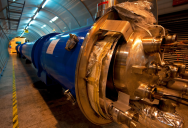Researchers Discover The Heaviest Antimatter Atomic Neutron Ever While Researching Why There Is More Matter In The Universe

Why are we here? Why does anything exist? These are deep questions of philosophy, but they are also questions that physicists are trying to answer.
The universe is made up of many things, but all physical things are made of some type of matter. Scientists have known for some time now that there is also something called antimatter out there. When matter and antimatter come in contact, they become pure energy.
Scientists working at the Relativistic Heavy Ion Collider are trying to figure out why in the time after the big bang didn’t all the matter and antimatter come in contact and become energy. We know that today there is more matter than antimatter, but it is not at all clear why.
In an attempt to learn more about this, the scientists are colliding various particles together at high speeds, which simulates the environment at the big bang. These particles sometimes create new elements or other things, which can be studied to help the scientists learn more.
Recently, the scientists detected a new particle that has the heaviest atomic nucleus ever observed.
This particle is called antihyperhydrogen-4.

Junlin Wu is a graduate student at the Joint Department for Nuclear Physics at Lanzhou University and the Institute of Modern Physics in China. He discussed this in a statement:
“Our physics knowledge about matter and antimatter is that, except for having opposite electric charges, antimatter has the same properties as matter — same mass, same lifetime before decaying, and same interactions. Why our universe is dominated by matter is still a question, and we don’t know the full answer. To study the matter-antimatter asymmetry, the first step is to discover new antimatter particles. That’s the basic logic behind this study.”
Antihyperhydrogen-4 has an atomic nucleus made of one antiproton, two antineutrons, and one antihyperon known as an antilambda.
When this new type of nucleus was found, there were also 16 events monitored that were likely the antimatter particles associated with it. This means that the amount of matter and antimatter produced from this experiment was the same, keeping things in balance. Unfortunately, this also means that it doesn’t show how the universe at the big bang produced more matter than antimatter.
The study published in the journal Nature suggests that finding these heavy particles makes it easier to identify any potential variations, even if they haven’t been discovered yet.

It isn’t every day you discover the heaviest antimatter atomic nucleus ever.
If you thought that was interesting, you might like to read about a quantum computer simulation that has “reversed time” and physics may never be the same.

Sign up to get our BEST stories of the week straight to your inbox.




